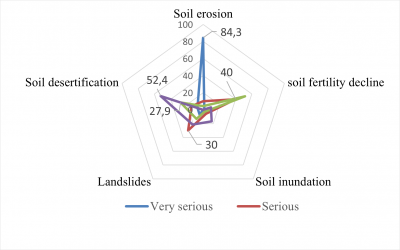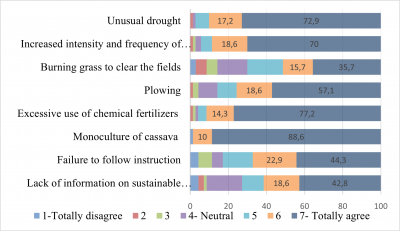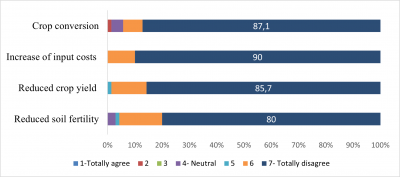Land degradation has emerged as a serious problem during the last few decades due to its adverse impact on food security. In Vietnam, one of the biggest concerns about land degradation is unsustainable farm practices in the upland areas of the northwestern region. Soil erosion triggered by heavy rains and cultivation on hillslopes, crop intensification to meet food demand of the growing population, and unsustainable farming practices largely constitute to degrading land.
Decades-long experience in agriculture allows farmers to be able to identify phenomena of degraded land through observation of soil physical properties, such as topsoil color and thickness, soil texture, soil aeration, water holding capacity, crop yields, etc. In other words, farmers’ perception and awareness of soil fertility can help them strategize best land management practices towards land and soil restoration. Besides, understanding farmers’ perception on land degradation can help authorities design plans for soil restoration and conservation measures through appropriate local development programs for adaptation and implementation at scale.
The research team conducted in-depth interviews with 80 family heads in Cau Vai village, Mau Dong commune, Van Yen district, Yen Bai province (Figure 1). The interview questionnaires consisted of both close and open-ended questions that included farmers’ perceptions of soil erosion (forms and causes), soil fertility decline and reasons, measures to restore degraded land.

Figure 1. Study site in Cau Vai village, Mau Dong commune
In this region, farmers perceived five existing forms of land degradation, in which soil degradation was identified as the most predominant form followed by desertification, inundation, landslides, and soil fertility decline (Figure 2).

Figure 2. Farmers perception of the forms of land degradation
The respondents identified eight reasons that caused land degradation in the region (Figure 3) in which long cassava monoculture and excessive use of chemical fertilizers are the main causes.

Figure 3. Farmers perception of the causes of land degradation

Figure 4. Farmers perception of land degradation consequences
Regarding the land degradation consequences (Figure 4), all of the respondents confirmed that land degradation leads to the increase in input costs for agricultural production e.g. fertilizers, pesticides, etc. in compromising yields and income. They also identified crop conversion from cassava to other alternative tree crops, such as cinnamon, reduced cassava yield and declined soil fertility as impacts of land degradation.
In response to land degradation problems, farmers have developed and used several adaptive management practices including (i) grass planting along contour lines; (ii) crop conversion; (iii) Cassava-contoured cassava stem fence. These inteventions play an important role in climate change adaptation strategies in many upland areas with climate vulnerability. In the next blog, we will assess the effectiveness of these interventions in-depth.
Vũ Thanh Biển, Climate-Resilient AgriFood Systems (CRAFS) research group

 Tiếng Việt
Tiếng Việt